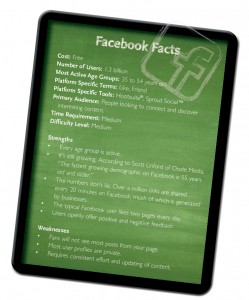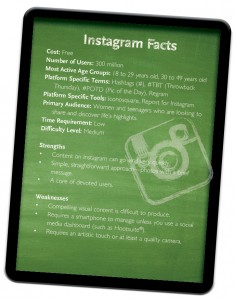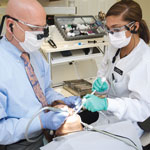
INTERNET MARKETING, PART 2: SOCIAL MEDIA FOR DENTAL PRACTICES.
In the previous issue of Aesthetic Dentistry, we discussed the impact of websites, mobile technology, and search engines on a dental practice’s visibility and reputation. Much of that article revolved around the content and structure of your website, mobile compatibility, response to reviews, blogging, and search engine optimization (SEO).
The world of social media is similar. If planned and executed well, social media efforts can serve as an accelerator that connects your practice with new and influential customers and validates your particular expertise. Using the following recommendations, learn how to reach out to new patients, leverage your current patients, and grow your business.
Social media is a modern public forum. Every day, billions of people share photos, personal messages, and opinions with the world. Social media is where average people can become “influencers” of their friends and families, and in some instances, larger communities. Today, consumers often make healthcare decisions by relying on the opinions of friends, as well as the ratings of complete strangers, through social media.
Tyson Hymas, director of SEO at SEO.com (a digital marketing firm) said, “With any social media platform you’re creating an army of marketers.” So why not leverage this potential to your advantage?
Social media is a game changer for many businesses, yet for members of the dental and medical worlds, it’s largely untapped. With a successful social media strategy, you can potentially increase your number of followers (the people who “like” your business), improve your practice’s visibility, and similarly increase the number of patients in your practice. In addition, social media offers a good chance to distinguish yourself from average dental practices and establish your practice as an excellent provider of advanced procedures.
Considering the low cost of entry and the potential to reach thousands of new customers, there’s no reason for a practice to be anti-social. Your opportunity awaits!
Have a Plan
Getting started with a social media strategy can be a bit overwhelming if you don’t have a good plan. Here are a few tips to keep in mind:
• Social media should include a conversational, relationship-driven approach. It is not best served with an overt sales approach.
• With social media, make sure your profile has a personal touch. Try to aim for a ratio of 20 percent of your own content and 80 percent of content that is created by others. According to Hymas, “The biggest thing is being current on trends in your industry, sharing that information to your audience, and not just throwing promotions and talking about yourself all the time.”
• The rules of the Health Insurance Portability and Accountability Act (HIPAA) apply on social media. Always obtain consent to refer to a specific patient online, and never conduct business directly with a patient through social media (appointment reminders, for example). Consent form templates can be found online, but consult with legal counsel regarding any questions before sharing information with or about patients online.
• Everything you post on social media should connect your practice to people in a personal, relevant way.
The Platforms
Set aside a few minutes each day to familiarize yourself with each social media platform and ask your network of friends how they use them. Each platform is unique and the requirements of engagement vary. I’ve chosen four popular social media sites to highlight. I’ve included some of the pros and cons of each platform and why dentists should take a closer look.


FACEBOOK
Facebook is a behemoth that cannot be ignored. While on the site, Facebook users are typically connecting with friends, family, brands, and even strangers.
Senior users (ages 55 years and older) are the fastest-growing segment on Facebook, but it’s still incredibly popular among Millennials (people born between 1980 and 1995). Nearly half of Millennials check Facebook in the morning, much the way previous generations read a printed newspaper.
Unlike other social media platforms, Facebook makes a dental practice’s information readily available. “Users can look at the reviews of a particular business, find the address, and get information, whereas [on] some other platforms you can’t get that,” said Hymas.
Contests and coupons are highly attractive to Facebook users, and they are a good way to incentivize likes and shares. But be aware that every piece of content you share is an opportunity for people to respond—positively or negatively.
Respond to comments in a timely manner and quickly diffuse negative comments by asking the dissatisfied person to take the conversation offline. Once the conversation is offline, maintain an understanding demeanor and willingness to address the problem, no matter how passionate the user may be.
Facebook for Dental Practices
Facebook is the best platform for cultivating a community of prospective patients. People are open to connecting to businesses on Facebook—particularly businesses that their friends endorse. Each Facebook user is a potential patient or advocate.
Like any community, it takes a mix of content to keep things interesting. Promote your practice with before-and-after photos, new services, and testimonials. Also include aspects of your practice’s personality, such as biographies of your staff and recaps of community service and volunteering. Mix in some educational material, too—oral care tips, links to new studies, and other content.
Photos are the most popular form of content on Facebook, so try to attach a visual of some sort to every post, even if it’s merely a thumbnail from a linked article. If you do this, Facebook will reward your profile by making your content visible on the News Feed (a list of stories on a user’s home page) of a higher percentage of your fans.
Facebook does not make your content visible to everyone who likes your page. Instead, the platform uses an algorithm to predict what content people want to see when logging in. Facebook shows users only certain items.
In a blog article called, “Show Up in the Facebook News Feed! 8 Things that Really Work,” author Danielle Cormier of Constant Contact® suggests ways to increase the likelihood of making it into a News Feed. Courmier suggests that consistent posts and engaging content are good ways to increase visibility of your practice.
Leave a call to action on your posts, inviting people to like or share your content. The more interaction your posts earn, the more visible your content will be. And the more people who see your posts, the more likes you’ll earn.
There are strategies to attract more likes. The first is with sponsored posts (you pay a small fee per click to guarantee that your page appears on users’ News Feeds). You can target a specific demographic, for example, 24 to 54 year old women who live in zip codes surrounding your practice.
According to Hymas, with sponsored posts, “You can spend $20.00 and it may reach 1,500 people. Your content will show up either in their News Feed or on the sidebar, and you can specify certain demographics.”
Another way to attract more likes is with contests. Offer a valuable service such as free teeth whitening to someone who likes your page or shares a post. Or consider using a third-party app such as AgoraPulse (www.agorapulse.com) to capture email addresses on top of likes, which is a great way to build your email database.
Finally, create content that engages patients on the procedures that you provide. If you want to do more full arch cases, make sure that you post content that highlights the outcomes you can deliver with that treatment. Patients will start asking you about full arch options rather than you always bringing up the topic with them.
Get creative and brainstorm about ways to reach your audience, such as posting a “case of the month” on a regular basis (keeping in mind and adhering to patient privacy laws).
Facebook users tend to “unlike” a page if it posts too often, so limit your postings to three or four a week. The only exception is during a major giveaway or promotion.


With a strict limit of just 140 characters per message, Twitter is built for rapid-fire expression and focused engagement. And that’s exactly how it’s used. Twitter reports more than 58 million tweets each day. Twitter’s strengths are the brevity of its format, a simple interface and real-time engagement potential.
Unlike Facebook, Twitter content isn’t filtered through an algorithm and Twitter doesn’t require a lengthy setup process. People see what others are posting as it happens, in order, in real time.
Twitter for Dental Practices
Dental practices leverage Twitter primarily to build influence and engage their patients. A good way to engage patients is to tweet out a brief, dental tip at a fixed time each week to your followers. For example, every Monday at noon, tweet out a tip on dental health for small children.
According to a Kaiser Family Foundation report (provided by the Henry J. Kaiser Family Foundation), “Women are the long, undisputed family healthcare decision makers, making 80 percent of family healthcare choices.” Tweeting weekly healthcare tips about children engages this demographic directly and will likely result in your patients retweeting that information to their friends and followers.
Advertise a weekly “dental health tweet” on your website, on internal office signage, and on appointment cards. Virtually all social media platforms (Twitter included) show how many followers you have in real time—something you just can’t get from traditional print media.
Twitter can also be used to solve some of the most vexing practice problems, such as last-minute cancellations. Create a Twitter handle specifically for appointment notifications, such as @drsmithappoint (15-character limit), and tweet out last-minute available appointments. With Twitter, you can quickly broadcast the vacancy to a large number of patients simultaneously.
Be sure to use hashtags on every tweet. Originating on Twitter, a hashtag is a word or phrase with a number sign at the beginning (for example, #Dentistry). They are used to organize content and conversations by specific topics across a platform.
Hashtags “tag” users who are interested in that specific content or subscribed to a specific user. By adding your locale’s hashtag (#NYC, #Columbus, #SLC), you expose your tweet to a wider audience than just your followers.
Like Facebook, Twitter is a channel for broadcasting promotions and contests. According to Hymas, “Twitter is more of an informational feed without as much of a local focus. You can promote your own blog post, or your promotions. If you want to do a contest (perhaps a free whitening tray kit), then ask people to sign up and retweet it.”


Instagram is a virtual photo and video album that you can share with your followers. In addition to photos, the service is built around short videos, with brief messages attached. The platform is designed for mobile devices, with a minimal presence on the web for desktop computers.
Instagram’s demographics tend to skew younger than other social networks, with a heavily devoted base of teenagers and twenty-somethings who check Instagram religiously—even more often than Facebook or Twitter.
With Instagram, users share selfies and other photos, and also hit the “Like” button on other people’s content, but at a much more rapid pace than on Facebook. Like Twitter, hashtags are popular on Instagram and are a great way to increase visibility.
Instagram for Dental Practices
Instagram is an artistic, multimedia-oriented network. It provides a visual platform for you to show your work on patients, the smiling faces of your staff, and much more. Instagram allows you to showcase the cases you are most proud of.
Every dental practice should have great photography of outstanding case outcomes. Post those images on Instagram and patients will see the results and initiate questions about the procedures you can provide. By nature, Instagram is visual and the tone is playful and fun, so keep that in mind when posting.
Instagram allows video uploads—but they must be fifteen seconds or less. No one expects a highly polished video. Dental offices can use videos to their advantage by making brief before-and-after clips, or describing a new service.
Like other social media platforms, Instagram offers promoted posts to increase exposure to new people. For example, ask patients to post their smiles and tag your practice in the photos. Then select a random winner for a free whitening session or giveaway.
Or give a free whitening session to a user who likes a particular post, also chosen at random. Ask followers to use your practice’s hashtag when they post their smiles for a freebie (people will gladly post photos for the chance of winning an inexpensive, branded T-shirt or swag). The text that you add to a photo can also include a link to wherever your contest is hosted, whether it’s on Facebook or your own website.
Once you have visual content, simply add in a few hashtags—for example, location (#Columbus), topic (#dentistry), and description (#smilemakeover). Add two or three hashtags to each post, and you’ll be surprised at the strangers who discover and like your content.


Pinterest is essentially an Internet scrapbook, or as the name implies, a virtual tackboard. The platform is built around users sharing links to content they find interesting or useful, called pins. People sort their pins by topic on virtual boards.
Each pin is assigned an image pulled from its page. The result is a board full of images, and a user’s page full of boards—all full of related images.
Pinterest is eminently browsable. If you have an interest in getting the perfect smile, for example, you can spend hours browsing through other users’ content without jumping off topic.
While browsing, users can repin content to their own boards, hit the “Like” button, or send the pin to another user. To create a pin, users must insert the URL on the Pinterest home page, click a “Pin It” button (if the site provides it), or right-click on a page if they have the Chrome or Firefox Pinterest plugin installed.
Pinterest for Dental Practices
Unlike Instagram, Pinterest requires more than a single photo to be effective. Yes, the imagery is crucial to getting users to click on your content, but there has to be something of interest on the other end of that click.
That means blogging and sharing your expertise and success. It means creating online case studies and instructional videos. And it means giving each piece of content a compelling image to complement it. These posts position you as an expert healthcare provider doing extraordinary work.
Much like Instagram, the imagery is what captures people’s attention, so it’s worth hiring a professional photographer to spend a day in your practice capturing your staff at work and smiling patients. Or purchase a nice camera and periodically ask someone to use it to document your day and the details of your practice.
Use photos as the primary images while sharing pieces of content on Pinterest (not to mention on Facebook and other social networks, which also rely heavily on imagery).
Since 83 percent of Pinterest users are women between the ages of 18 and 34 years old (according to Pinterest), gear your content toward them. Add some words or a headline to your imagery to increase the quick “get it” factor.
Like other social media platforms, Pinterest can host contests. Offer a free service to a random user who repins your contest’s landing page or follows your boards, or a smaller prize to someone who can find a secret phrase on a page you’ve pinned (a Pinterest scavenger hunt, so to speak).
One final idea—encourage your staff to create their own boards. It gives your practice a solid foundation of people to share your content with, and it also helps create more personal connections between your team and your patients.
STRATEGIES FOR ALL PLATFORMS
Remember, you have to start somewhere, so choose a platform and get started! Once you are comfortable with that platform, you’ll naturally discover what works best to capture attention and engage your audience. In the meantime, keep the following concepts in mind, regardless of the platform you’re using:
Always include a call to action, usually in the form of a link. Anytime you’re sharing your own content, give people something to do—retweet, comment, or, “click here to learn more.”
Be ready to respond anytime. Studies show that the quicker the response to a complaint, the more likely an upset customer will be placated.
Post photos (and short videos). If you’re unsure what to post, photos and short videos are always popular and can be posted across every network.
Utilize hashtags. Hashtags are great tools for new audiences on Twitter, Facebook, and Instagram. Use at least one on every post. Here’s a sample:
Smile, ABC Dental has added another member to our team. Please welcome Sara, our new hygienist! #Dallas #Hygienist #Smile.(For more information on hashtags and how to track them go to https://www.hashtags.org/.)
Promote social media channels in-house. Do your pamphlets and other promotional materials include an invitation to connect via social media? Personally ask your patients to connect via social media and train your staff to mention it to patients as they exit the practice. (Keep in mind that Google may penalize your practice in search rankings if they detect you’re earning likes directly from your office).
Incentivize cross-platform usage. It’s rare that someone connects with your practice across three or four platforms. Each person will likely consume information in different ways, whether with personal updates, photos, contests, or testimonials. Use contests to entice people to follow you on multiple networks, which gives your content a good chance to be viewed.
Mix it up! Don’t assume your audience is the same across every platform. Hymas suggests, “Mix up the verbiage just a little bit, so it seems a bit more real, because people tend to trust that more than just automated pushes on the different platforms.”
Your best patients can be your best advocates. Some of the happiest moments of a patient’s life may happen in your office after a dazzling procedure! These moments should make you proud as a dentist and they can be capitalized for the overall benefit of your practice.
Find What Works but Never Lose Touch
To get started, focus on one social media site and maintain a minimal presence on the others. In each platform’s settings, be sure you’ve activated alerts through email, push notifications, and/or texts. To find mentions of your practice that don’t directly reference your specific profiles (“Jones Dental” instead of “@JonesDental”), set up keyword alerts through a social media dashboard.
Finally, always have a protocol in place for responses. It’s important to task someone for responding professionally to every situation—whether it’s a compliment from a customer or a complaint.
With the right content and a touch of personality, social media can be a major boon to your practice. People are looking for exactly the types of services and procedures you offer. And with the conversational nature of social platforms, you can engage them directly.
There’s no reason to be anti-social—insert your practice into the online conversation and start connecting with new patients!
Use this link to read Internet Marketing, Part 1 http://adentmag.com/out-of-site-out-of-mind-internet-marketing-tips-part-i/










